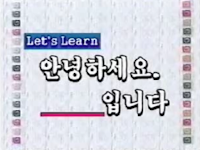About - how much something is.
 The main idea of this lesson is about how to count money using the numbering system borrowed from Chinese numbers. Lesson 9 explains two numbering systems in Korean, and this lesson will provide you with some examples and exercises.
The main idea of this lesson is about how to count money using the numbering system borrowed from Chinese numbers. Lesson 9 explains two numbering systems in Korean, and this lesson will provide you with some examples and exercises.원 (Won) is the unit for Korean currency. "(A) 원이에요" means that it would be (A) Won.
In the video clip,
Owner: 어서오세요, 뭐 드릴까요? --- Welcome, what can I get for you?
Customer: 이 사과 얼마예요? ------- How much are these apples?
Owner: 천이백 원이에요. ----------- It is 1,200 Won (per apple).
Customer: 비싸요, 저 사과는 얼마예요? -- It's expensive, how much are those apples?
Owner: 팔백 원이에요. ------------- It is 800 Won (per apple).
Customer: 맛있어요? --------------- Is it delicious?
Owner: 네, 맛있어요. --------------- Yes, It is delicious.
Customer: 저 사과 주세요. ---------- Please give me those apples.
Owner: 몇 개 드릴까요? ------------ How many apples can I get for you?
Customer: 네 개 주세요. ------------ Four apples, please.
Owner: 잠깐만 기다리세요. --------- One moment, please.
..........................
Owner: 삼천이백 원이에요. --------- It would be 3,200 Won.
Customer: 돈 여기 있어요. ----------- Here is the money.
Owner: 고맙습니다. 안녕히 가세요. --- Thank you. See you later.
In this conversation, there are three expressions about "(A) 원이에요"; 천이백 원이에요, 팔백 원이에요 and 삼천이백 원이에요. Considering how to read numbers in Korean from the lesson 9, this expression is easy to learn. First, read a number and add the unit for currency. For example,
983,453 원이에요.
1) read the number 983,453: 구십팔만 삼천사백오십삼
2) add the simple expression - 원이에요.
구십팔만 삼천사백오십삼 원이에요.
For more exercises, I'd like you to read the sentences in Korean.
1) 10,300 원이에요.
2) 100 원이에요.
3) 1,930 원이에요.
4) 54,157,319 원이에요.
5) 189,372,400 원이에요.
Expressions
비싸요 (bi-ssa-yo) --- It's expensive.
More resources for learning Korean:
infocobuild Learning Korean









